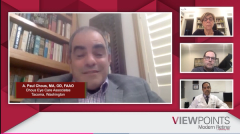
ADA guidelines for DR/DME management
Episodes in this series

Rishi Singh, MD: In this section, we’ll be discussing treatment options for diabetic retinopathy [DR] and diabetic macular edema [DME]. We’ll start off with Dr Ferrucci, and we’ll ask what the recommended treatment guidelines are. When is observation appropriate for the patient with DME or diabetic retinopathy?
Steven G. Ferrucci, OD, FAAO: As an optometrist, when we have a patient with mild or moderate nonproliferative diabetic retinopathy, I’d feel that we can safely see those patients. Once the retinopathy starts to get a bit worse rather than moderate, it makes sense to consider a referral. For diabetic macular edema, if the patient’s vision is reduced from the diabetic macular edema, then that’s a clear-cut time to get a referral to a retinal specialist. The patients who have diabetic macular edema with great or perfect vision are a bit more complicated. I will usually get a second opinion for those patients. I realize that they might not always be treated, but it makes sense to at least get a second opinion.
Rishi Singh, MD: Dr Chous, we have all these guidelines from the ADA [American Diabetes Association] with regard to follow-up in these patients. Tell us about how you use them. Do you go by the book on all of them as far as 6 months for a mild nonproliferative to a patient with moderate nonproliferative disease? How do you practically use those guidelines from the ADA?
A. Paul Chous, MA, OD, FAAO: The ADA says it should be 1 to 2 years if the patient has no or minimal DR and good metabolic control. They amorphously say good metabolic control. I’m looking at that, and what is more important than A1C [glycated hemoglobin], which is what the new endocrine research is showing, is what percentage of the patient’s life are they within a normal glucose range, which is called the glucose time in range. It’s independently predictive of DR and vision loss outside of hemoglobin A1C.
My general strategy if a patient has mild or no disease is to perform an annual examination. It could be done less often to save money, which I get from an economic standpoint, but there is value in habituation for the patient, which means getting used to having annual dilated exams. As optometrists, we see this all the time. We tell patients, “Throw your contact lenses away every 2 weeks or every month,” and sure enough, when they come back, we learn that they’re throwing them away every 6 months. There’s value in getting patients acclimatized to coming in more often.
A panel of experts in ophthalmology and optometry review the diagnosis and treatment of diabetic eye disease including emerging agents in the field.
Newsletter
Keep your retina practice on the forefront—subscribe for expert analysis and emerging trends in retinal disease management.


















































